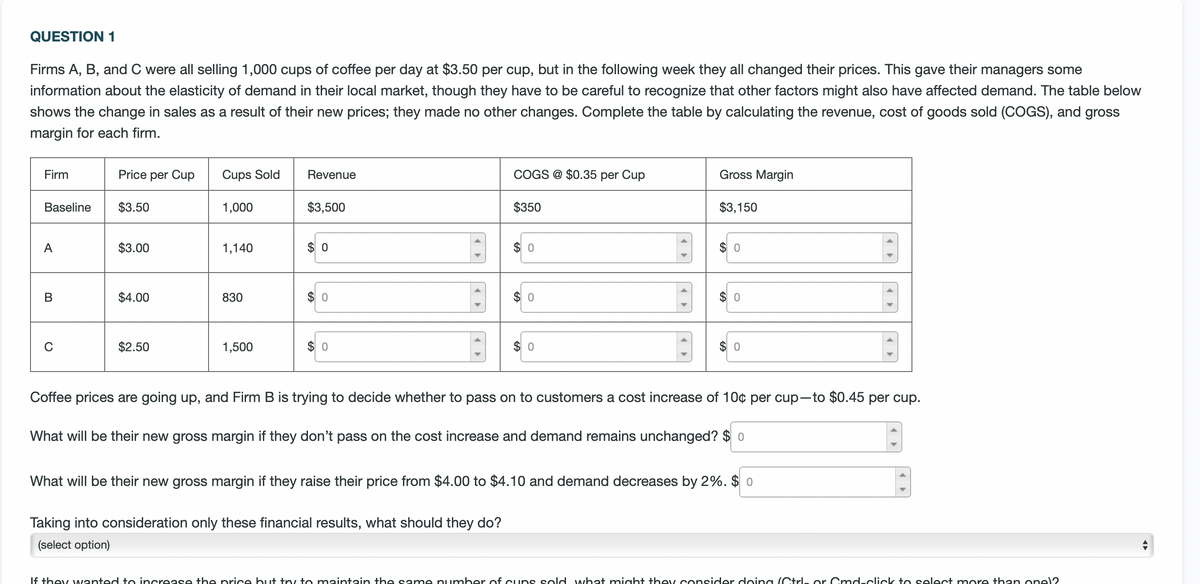QUESTION 1 Firms A, B, and C were all selling 1,000 cups of coffee per day at $3.50 per cup, but in the following week they all changed their prices. This gave their managers some information about the elasticity of demand in their local market, though they have to be careful to recognize that other factors might also have affected demand. The table below shows the change in sales as a result of their new prices; they made no other changes. Complete the table by calculating the revenue, cost of goods sold (COGS), and gross margin for each firm. Firm Baseline A B с Price per Cup $3.50 $3.00 $4.00 $2.50 Cups Sold 1,000 1,140 830 1,500 Revenue $3,500 $0 $0 $0 COGS @ $0.35 per Cup $350 0 Taking into consideration only these financial results, what should they do? (select option) 0 $0 Gross Margin $3,150 $0 $0 $0 Coffee prices are going up, and Firm B is trying to decide whether to pass on to customers a cost increase of 10¢ per cup-to $0.45 per cup. What will be their new gross margin if they don't pass on the cost increase and demand remains unchanged? $ o What will be their new gross margin if they raise their price from $4.00 to $4.10 and demand decreases by 2%. $0 #
QUESTION 1 Firms A, B, and C were all selling 1,000 cups of coffee per day at $3.50 per cup, but in the following week they all changed their prices. This gave their managers some information about the elasticity of demand in their local market, though they have to be careful to recognize that other factors might also have affected demand. The table below shows the change in sales as a result of their new prices; they made no other changes. Complete the table by calculating the revenue, cost of goods sold (COGS), and gross margin for each firm. Firm Baseline A B с Price per Cup $3.50 $3.00 $4.00 $2.50 Cups Sold 1,000 1,140 830 1,500 Revenue $3,500 $0 $0 $0 COGS @ $0.35 per Cup $350 0 Taking into consideration only these financial results, what should they do? (select option) 0 $0 Gross Margin $3,150 $0 $0 $0 Coffee prices are going up, and Firm B is trying to decide whether to pass on to customers a cost increase of 10¢ per cup-to $0.45 per cup. What will be their new gross margin if they don't pass on the cost increase and demand remains unchanged? $ o What will be their new gross margin if they raise their price from $4.00 to $4.10 and demand decreases by 2%. $0 #
Microeconomics: Private and Public Choice (MindTap Course List)
16th Edition
ISBN:9781305506893
Author:James D. Gwartney, Richard L. Stroup, Russell S. Sobel, David A. Macpherson
Publisher:James D. Gwartney, Richard L. Stroup, Russell S. Sobel, David A. Macpherson
Chapter7: Consumer Choice And Elasticity
Section: Chapter Questions
Problem 13CQ: Suppose Erin, the owner-manager of a local hotel projects the following demand for her rooms: a....
Related questions
Question

Transcribed Image Text:QUESTION 1
Firms A, B, and C were all selling 1,000 cups of coffee per day at $3.50 per cup, but in the following week they all changed their prices. This gave their managers some
information about the elasticity of demand in their local market, though they have to be careful to recognize that other factors might also have affected demand. The table below
shows the change in sales as a result of their new prices; they made no other changes. Complete the table by calculating the revenue, cost of goods sold (COGS), and gross
margin for each firm.
Firm
Baseline
A
B
C
Price per Cup
$3.50
$3.00
$4.00
$2.50
Cups Sold
1,000
1,140
830
1,500
Revenue
$3,500
$0
0
0
COGS @ $0.35 per Cup
$350
$0
$0
$0
Gross Margin
$3,150
$0
$0
$0
Coffee prices are going up, and Firm B is trying to decide whether to pass on to customers a cost increase of 10¢ per cup-to $0.45 per cup.
What will be their new gross margin if they don't pass on the cost increase and demand remains unchanged? $ 0
What will be their new gross margin if they raise their price from $4.00 to $4.10 and demand decreases by 2%. $0
Taking into consideration only these financial results, what should they do?
(select option)
If they wanted to increase the price but try to maintain the same number of cups sold what might they consider doing (Ctrl- or Cmd-click to select more than one)?
Expert Solution
This question has been solved!
Explore an expertly crafted, step-by-step solution for a thorough understanding of key concepts.
This is a popular solution!
Trending now
This is a popular solution!
Step by step
Solved in 4 steps

Knowledge Booster
Learn more about
Need a deep-dive on the concept behind this application? Look no further. Learn more about this topic, economics and related others by exploring similar questions and additional content below.Recommended textbooks for you

Microeconomics: Private and Public Choice (MindTa…
Economics
ISBN:
9781305506893
Author:
James D. Gwartney, Richard L. Stroup, Russell S. Sobel, David A. Macpherson
Publisher:
Cengage Learning

Economics: Private and Public Choice (MindTap Cou…
Economics
ISBN:
9781305506725
Author:
James D. Gwartney, Richard L. Stroup, Russell S. Sobel, David A. Macpherson
Publisher:
Cengage Learning


Microeconomics: Private and Public Choice (MindTa…
Economics
ISBN:
9781305506893
Author:
James D. Gwartney, Richard L. Stroup, Russell S. Sobel, David A. Macpherson
Publisher:
Cengage Learning

Economics: Private and Public Choice (MindTap Cou…
Economics
ISBN:
9781305506725
Author:
James D. Gwartney, Richard L. Stroup, Russell S. Sobel, David A. Macpherson
Publisher:
Cengage Learning


Managerial Economics: A Problem Solving Approach
Economics
ISBN:
9781337106665
Author:
Luke M. Froeb, Brian T. McCann, Michael R. Ward, Mike Shor
Publisher:
Cengage Learning

